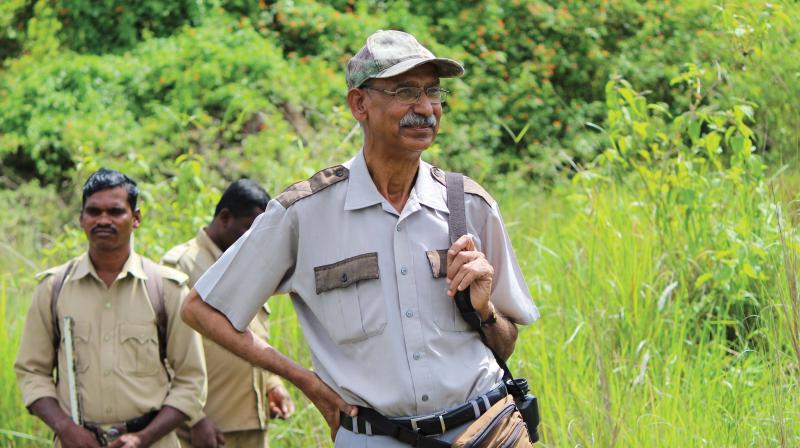We have forgotten how to live harmoniously with Nature: KM Chinnappa
Mr Chinnappa says the need of the hour is to leave things as they are, till nature heals the damage on its own.

As a forest officer, he did everything possible to save Nagarahole (now Rajiv Gandhi National Park) from poachers and smugglers. Consequently, in 1993, the forest mafia joined hands and burnt down Nagarahole as well as his house around 20 km away from the forests. Though he quit his job, he could not stay away from his passion. He started visiting schools and educated children about conservation of wildlife, forests and the environment. He, along with some friends set up Wildlife First and fought a legal battle against Kudremukh Iron Ore Company Limited (KIOCL) and ensured iron ore mining was stopped in the Western Ghats. On the natural calamity in Kodagu and large-scale destruction, K.M. Chinnappa feels this is the way nature takes its revenge when it is disturbed. He contends that nature also takes remedial measures to set things right if it is left alone without human intervention. In an interview with Vinay Madhav, Mr Chinnappa says the need of the hour is to leave things as they are, till nature heals the damage on its own. Here are excerpts from the interview.
What is your opinion on the tragedy that struck Kodagu?
One has to be very cautious while dealing with any hilly region, not only the Western Ghats. Now that it has struck Madikeri, we are debating so many issues like the Dr Kasturirangan report or Madhav Gadgil report. Let us look back at what happened in Kedarnath in 2013 or even at Rio in Brazil. The hills came sliding down due to heavy rain, along with rocks. Even Madikeri had experienced such rains earlier but the landslides took place only this year. Over a period of time, we have been disturbing nature in the name of development. We are doing this without any scientific monitoring. Every hill is covered with top soil and boulders which are held together by grass, trees and creepers. When we remove them, we should have a mechanism to stablise them with an alternative. We should find a way to cut the hill slopes and stablise them before building houses, roads and other things. Who is monitoring them here? Over a period of time, the soil will get loose and boulders too will have no obstacles to roll down. When they slide down, we call it nature’s fury. For example, my paddy field in Srimangala usually needs seven inches of rain to get flooded. Now, with two inches of rain, it has started flooding. Earlier, everyone used to cultivate paddy and now they have abandoned it. Some have also converted the fields into residential areas. Consequently, the streams have lost direction. Wherever people have built houses in paddy fields, water gets into their houses.
Do you feel development activities should be curbed in hilly regions?
It has to be regulated. In most developed countries, any cutting into hills comes with a stabilization plan. They don’t cut into it vertically. Besides, they put iron meshes as support to cut into the area and allow natural vegetation to grow on that. In India or other developing countries, no such measures are taken. No one monitors stabilization in hilly regions. Let us come back to Madikeri and surrounding areas. There are any number of irrigation ponds in the estates on the slopes. Though it looks plane, there will be a slope down and no one has made a scientific study on the impact of such man-made ponds. When it comes to housing and tourism activity in this region, no one has been able to regulate both. Houses are built wherever land is available and tourism was allowed without checking the carrying capacity of the region. Worse, Indian tourists, especially the new generation of IT/BT professionals do not have tourist culture. In a bid to accommodate more tourists, people disturb more areas.
What do you think is the solution for this problem?
I have no idea. However, nature can take remedial measures for the damage we do. For that to happen, we have to leave it alone. Now, there is damage in Madikeri. Instead of trying to rebuild it, leave the damaged area as it is for some time. Nature will start reclaiming itself in the best suitable way. The best example is Kudremukh itself. In 2005, the Supreme Court ordered closure of mining operations. At that time, Rs 48 crore was allotted for rebuilding the natural habitat. I asked them not to spend any money and keep away from the place. Today, the entire region has almost bounced back. Earlier, Bhadra River from Kudremukh region used to be red. You can go and see it now, the water is crystal clear.
Will the implementation of the Kasturirangan report help in avoiding future damage?
I don’t think the Kasturirangan report is the final solution for all the problems haunting the Western Ghats. There are two aspects of the Kasturirangan report. First, who will ensure implementation of the report in toto? Vested interests and politicians will not allow that to happen. If they were keen, how do we have so many unauthorized settlements around Madikeri itself? Secondly, so many sensitive areas are already disturbed. What will happen to them? The activities will continue as usual. You can’t give a time frame on when these disasters will happen or where. It is Madikeri today, it may happen in other place some other day. It is not that Madikeri has not witnessed such rain in history. The disturbance of nature was not so much and so we did not have disasters of this scale.
So what do you feel the future holds for the Western Ghats?
We need the Western Ghats for survival, we cannot go on destroying it. Basically, we have lost the foundation for living harmoniously with nature. Our parents adhered to the concept of having a forest for a village and worshipped a huge tree on top of a hill. The basic idea was to make people walk that distance uphill and improve their health. What have we done now? We commercialized such places and when money started pouring in, we built roads and accommodation for people in the most unscientific way in fragile ecosystems. When such things happen in Kerala and other places, I keep wondering how Sabarimala temple is still on the top of the hill and has not come down. The amount of environmental damage done around Sabarimala is huge and the bomb is ticking. The solutions are simple and local, but instead, we go in search of them globally.

